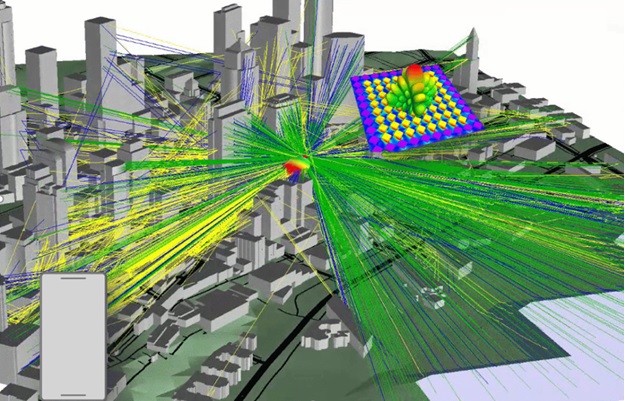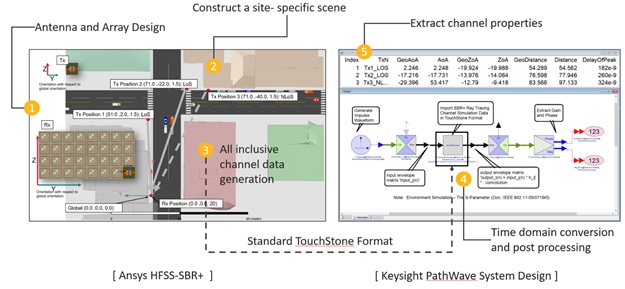Ansys and Keysight wanted to see if they could answer the question, If we put virtual cellphones in different locations in a city, can we predict what kind of 5G signal we’re going to get in those locations? To find out, they created and tested a detailed virtual model of a city, including a variety of 5G antennae, receivers, and transmitters typically found in a high-density urban area. It turns out, we can.
The team used Ansys HFSS to construct 5G MIMO base station antenna array models and handset antenna models for a 28 GHz, high-band system and placed them in different locations around a realistic city model. From there, they used HFSS SBR+ to figure out what was really happening between the antennas by using physics to model the propagation of signals between the base station and the handsets.

5G Signal propagation through complex city environments is modeled with a Shooting and Bouncing Rays (SBR) electromagnetic field solver. These signal propagation simulations are linked to detailed Ansys HFSS phased array base station and handset antenna system models.
Together, Ansys and Keysight tested a proof of concept for an accurate, physics-based virtualized process for understanding 5G physical channel behavior. The prototype was a true partnership between Ansys and Keysight capabilities. Ansys methodology was leveraged to model the physical layer—virtual antennas, scattering, and their coupling tendencies—on top of Keysight’s method for modeling the actual 5G radio architecture and beam selection process.

Ansys HFSS and HFSS SBR+ are used to compute the physical channel response for an installed 5G base station array and user equipment antennas, and Keysight SystemVue extracts the time domain channel properties, recreating user signal angle of arrival for MIMO beamforming.
Eventually, virtual modeling will take the place of the “hunt and peck” method of installing and adjusting 5G base stations to maximize coverage. For detailed information on the proof of concept, check out our recent webinar, 5G mm-wave Physical Channel Modeling with EM Physics.
What problems can we solve with 5G virtual modeling?
5G promises mid-band and high-band channels capable of delivering massive quantities of data at blindingly fast speeds. 5G radio equipment vendors and wireless service providers quote impressive capabilities for high-band systems at 28 and 39 GHz. The catch is: these systems are only cost effective in high-population areas, like city centers.
There are four main factors that complicate 5G systems beyond what we were seeing at lower-band frequencies:
More Drops
At high frequencies, the farther away from the base station, the more signals are dropped. The speed of drop off is about ten times faster in 5G. A highly populated area requires many more access points to service all subscribers.
Low Signal Penetration
Signals have a hard time penetrating common building materials at high bands in the mm-wave frequencies. A 4G mobile phone inside a building can receive signal from a cellular tower miles away because these lower frequency longer wavelength signals can penetrate the structures and surfaces between the phone and the tower. At the higher frequency 5G bands, buildings go from acting like signal sponges to acting like mirrors. At 28GHz, a popular 5G high band frequency, plate glass (1.5-centimeter thickness) reduces signal penetration by a factor of one thousand. Physically thicker cement and brick pose even worse attenuation. The mirror effect of exterior surfaces creates another problem: delay spread. With signals bouncing everywhere, receivers get delayed copies of the signal, making receiver design much more complicated.
Distance Loss
5G systems operate using antennas that concentrate signal energy in spot beams to overcome the signal distance losses that increase more quickly than in 4G. It’s critical to identify the right locations for access points such that every subscriber is covered with minimal overlap. It’s possible to test real-world installations and locations, but it’s time consuming and expensive. High-frequency, high-bandwidth measurement equipment is considerably more expensive, even cost prohibitive at times.
Bureaucratic Delay
Getting a permit from a city council or other governing body to install a 5G antenna system can be an arduous process. Nobody wants to get approved for 10 mount locations and find out that 5 of them are non-optimal, so they need to go back to the drawing board and re-apply with the city. The key is to identify the right number of access points, in the right locations, to offer consistent coverage with the fewest number of access points possible.
All of these issues can be solved with a virtualized process. Can we let the computer show us how well we’re serving a city’s subscribers? Ansys and Keysight say yes.

Animation of the E-fields of a 28 GHz signal with 400 MHz bandwidth traveling from a phased array base station model into a city environment. The signal bounces off the street (bottom) and the wall of a facing building (right). Single frequency electric field is shown in the top left for 2 cut planes.
What does the future of the electronics industry look like?
The short answer: partnerships. After many years of competing, Ansys and Keysight see more ways to move the industry forward by working as a complementary pair.
“Between Ansys and our partners, we stand a chance at creating the first digital twin of a 5G network that can cooperate with an actual, living network,” said Shawn Carpenter, Program Director 5G & Space at Ansys.
Using the existing prototype, Ansys and Keysight can tell you what signals are transmitted and received, but it’s much harder to address the five or six network layers that might be involved when a subscriber pulls out their smart phone to use a navigational app. How do we identify the shortest route across the network to the Cloud? How do we get data to the Cloud while maintaining data integrity? What delays do we expect in getting data our handset requests?
Many of the data communications issues are simply outside Ansys HFSS’ purview. The environment we use for our electromagnetics modeling is fantastic for modeling antenna systems or radio frequency components, but it’s not designed to model complete cities with interconnected cars driving up and down the streets, drones flying through it, and aircraft flying over the top.
In 2020, Ansys acquired Analytical Graphics Incorporated (AGI), a specialist in multi-domain mission engineering. AGI has incredible capabilities that extend into the 5G space too. This prototype included a few subscribers, but the real world is a lot more dense, and AGI’s know-how will assist in evaluating complex networks and simulating at scale. AGI also partners with Scalable Network Technologies, a master at answering these kinds of questions. Just recently, Scalable Networks was acquired by Keysight. To entangle the knot even further, AGI already has an existing interface for their network modeling tools inside of Keysight’s STK Interface. Between Ansys, Keysight, AGI, Scalable Network Technologies, and our other complementary partners, we have what we need to simulate and emulate at scale, and we’ll continue to polish our workflow integration.
Also Read
Is Ansys Reviving the Collaborative Business Model in EDA?
A Practical Approach to Better Thermal Analysis for Chip and Package
Share this post via:





Comments
There are no comments yet.
You must register or log in to view/post comments.